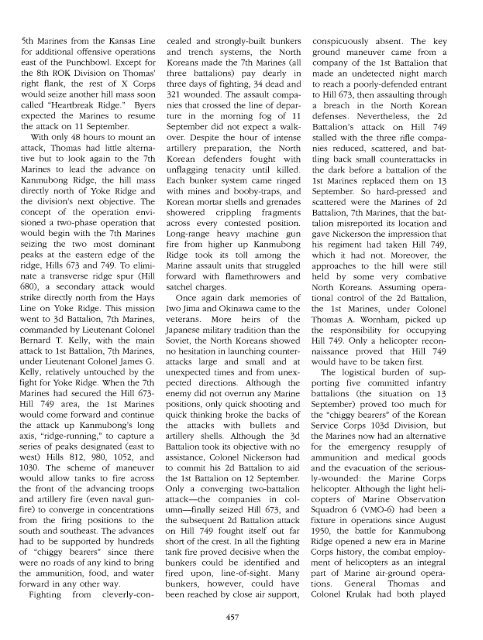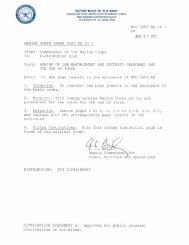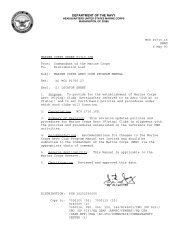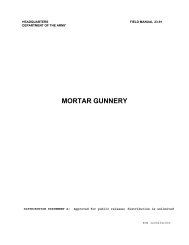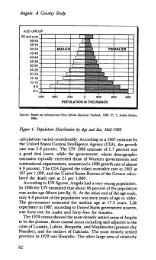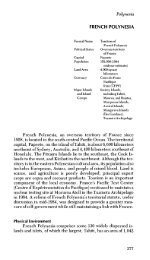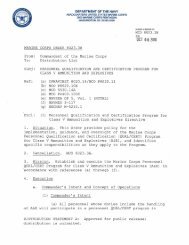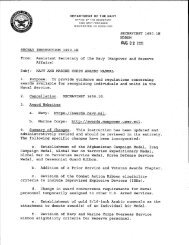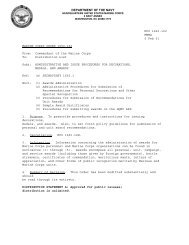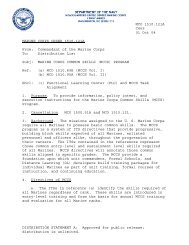US Marines in the Korean War PCN 10600000100_19 - Marine Corps
US Marines in the Korean War PCN 10600000100_19 - Marine Corps
US Marines in the Korean War PCN 10600000100_19 - Marine Corps
Create successful ePaper yourself
Turn your PDF publications into a flip-book with our unique Google optimized e-Paper software.
5th <strong>Mar<strong>in</strong>es</strong> from <strong>the</strong> Kansas L<strong>in</strong>e<br />
for additional offensive operations<br />
east of <strong>the</strong> Punchbowl. Except for<br />
<strong>the</strong> 8th ROK Division on Thomas'<br />
right flank, <strong>the</strong> rest of X <strong>Corps</strong><br />
would seize ano<strong>the</strong>r hill mass soon<br />
called "Heartbreak Ridge." Byers<br />
expected <strong>the</strong> <strong>Mar<strong>in</strong>es</strong> to resume<br />
<strong>the</strong> attack on 11 September.<br />
With only 48 hours to mount an<br />
attack, Thomas had little alternative<br />
but to look aga<strong>in</strong> to <strong>the</strong> 7th<br />
<strong>Mar<strong>in</strong>es</strong> to lead <strong>the</strong> advance on<br />
Kanmuhong Ridge, <strong>the</strong> hill mass<br />
directly north of Yoke Ridge and<br />
<strong>the</strong> division's next objective. The<br />
concept of <strong>the</strong> operation envisioned<br />
a two-phase operation that<br />
would beg<strong>in</strong> with <strong>the</strong> 7th <strong>Mar<strong>in</strong>es</strong><br />
seiz<strong>in</strong>g <strong>the</strong> two most dom<strong>in</strong>ant<br />
peaks at <strong>the</strong> eastern edge of <strong>the</strong><br />
ridge, Hills 673 and 749. To elim<strong>in</strong>ate<br />
a transverse ridge spur (Hill<br />
680), a secondary attack would<br />
strike directly north from <strong>the</strong> Hays<br />
L<strong>in</strong>e on Yoke Ridge. This mission<br />
went to 3d Battalion, 7th <strong>Mar<strong>in</strong>es</strong>,<br />
commanded by Lieutenant Colonel<br />
Bernard T. Kelly, with <strong>the</strong> ma<strong>in</strong><br />
attack to 1st Battalion, 7th <strong>Mar<strong>in</strong>es</strong>,<br />
under Lieutenant Colonel James G.<br />
Kelly, relatively untouched by <strong>the</strong><br />
fight for Yoke Ridge. When <strong>the</strong> 7th<br />
<strong>Mar<strong>in</strong>es</strong> had secured <strong>the</strong> Hill 673-<br />
Hill 749 area, <strong>the</strong> 1st <strong>Mar<strong>in</strong>es</strong><br />
would come forward and cont<strong>in</strong>ue<br />
<strong>the</strong> attack up Kanmubong's long<br />
axis, "ridge-runn<strong>in</strong>g," to capture a<br />
series of peaks designated (east to<br />
west) Hills 812, 980, 1052, and<br />
1030. The scheme of maneuver<br />
would allow tanks to fire across<br />
<strong>the</strong> front of <strong>the</strong> advanc<strong>in</strong>g troops<br />
and artillery fire (even naval gunfire)<br />
to converge <strong>in</strong> concentrations<br />
from <strong>the</strong> fir<strong>in</strong>g positions to <strong>the</strong><br />
south and sou<strong>the</strong>ast. The advances<br />
had to be supported by hundreds<br />
of "chiggy bearers" s<strong>in</strong>ce <strong>the</strong>re<br />
were no roads of any k<strong>in</strong>d to br<strong>in</strong>g<br />
<strong>the</strong> ammunition, food, and water<br />
forward <strong>in</strong> any o<strong>the</strong>r way.<br />
Fight<strong>in</strong>g from cleverly-con-<br />
cealed and strongly-built bunkers<br />
and trench systems, <strong>the</strong> North<br />
<strong>Korean</strong>s made <strong>the</strong> 7th <strong>Mar<strong>in</strong>es</strong> (all<br />
three battalions) pay dearly <strong>in</strong><br />
three days of fight<strong>in</strong>g, 34 dead and<br />
321 wounded. The assault companies<br />
that crossed <strong>the</strong> l<strong>in</strong>e of departure<br />
<strong>in</strong> <strong>the</strong> morn<strong>in</strong>g fog of 11<br />
September did not expect a walkover.<br />
Despite <strong>the</strong> hour of <strong>in</strong>tense<br />
artillery preparation, <strong>the</strong> North<br />
<strong>Korean</strong> defenders fought with<br />
unflagg<strong>in</strong>g tenacity until killed.<br />
Each bunker system came r<strong>in</strong>ged<br />
with m<strong>in</strong>es and booby-traps, and<br />
<strong>Korean</strong> mortar shells and grenades<br />
showered crippl<strong>in</strong>g fragments<br />
across every contested position.<br />
Long-range heavy mach<strong>in</strong>e gun<br />
fire from higher up Kanmubong<br />
Ridge took its toll among <strong>the</strong><br />
Mar<strong>in</strong>e assault units that struggled<br />
forward with flamethrowers and<br />
satchel charges.<br />
Once aga<strong>in</strong> dark memories of<br />
Iwo Jima and Ok<strong>in</strong>awa came to <strong>the</strong><br />
veterans. More heirs of <strong>the</strong><br />
Japanese military tradition than <strong>the</strong><br />
Soviet, <strong>the</strong> North <strong>Korean</strong>s showed<br />
no hesitation <strong>in</strong> launch<strong>in</strong>g counterattacks<br />
large and small and at<br />
unexpected times and from unexpected<br />
directions. Although <strong>the</strong><br />
enemy did not overrun any Mar<strong>in</strong>e<br />
positions, only quick shoot<strong>in</strong>g and<br />
quick th<strong>in</strong>k<strong>in</strong>g broke <strong>the</strong> backs of<br />
<strong>the</strong> attacks with bullets and<br />
artillery shells. Although <strong>the</strong> 3d<br />
Battalion took its objective with no<br />
assistance, Colonel Nickerson had<br />
to commit his 2d Battalion to aid<br />
<strong>the</strong> 1st Battalion on 12 September.<br />
Only a converg<strong>in</strong>g two-battalion<br />
attack—<strong>the</strong> companies <strong>in</strong> column—f<strong>in</strong>ally<br />
seized Hill 673, and<br />
<strong>the</strong> subsequent 2d Battalion attack<br />
on Hill 749 fought itself out far<br />
short of <strong>the</strong> crest. In all <strong>the</strong> fight<strong>in</strong>g<br />
tank fire proved decisive when <strong>the</strong><br />
bunkers could be identified and<br />
fired upon, l<strong>in</strong>e-of-sight. Many<br />
bunkers, however, could have<br />
been reached by close air support,<br />
457<br />
conspicuously absent. The key<br />
ground maneuver came from a<br />
company of <strong>the</strong> 1st Battalion that<br />
made an undetected night march<br />
to reach a poorly-defended entrant<br />
to Hill 673, <strong>the</strong>n assault<strong>in</strong>g through<br />
a breach <strong>in</strong> <strong>the</strong> North <strong>Korean</strong><br />
defenses. Never<strong>the</strong>less, <strong>the</strong> 2d<br />
Battalion's attack on Hill 749<br />
stalled with <strong>the</strong> three rifle companies<br />
reduced, scattered, and battl<strong>in</strong>g<br />
back small counterattacks <strong>in</strong><br />
<strong>the</strong> dark before a battalion of <strong>the</strong><br />
1st <strong>Mar<strong>in</strong>es</strong> replaced <strong>the</strong>m on 13<br />
September. So hard-pressed and<br />
scattered were <strong>the</strong> <strong>Mar<strong>in</strong>es</strong> of 2d<br />
Battalion, 7th <strong>Mar<strong>in</strong>es</strong>, that <strong>the</strong> battalion<br />
misreported its location and<br />
gave Nickerson <strong>the</strong> impression that<br />
his regiment had taken Hill 749,<br />
which it had not. Moreover, <strong>the</strong><br />
approaches to <strong>the</strong> hill were still<br />
held by some very combative<br />
North <strong>Korean</strong>s. Assum<strong>in</strong>g operational<br />
control of <strong>the</strong> 2d Battalion,<br />
<strong>the</strong> 1st <strong>Mar<strong>in</strong>es</strong>, under Colonel<br />
Thomas A. Wornham, picked up<br />
<strong>the</strong> responsibility for occupy<strong>in</strong>g<br />
Hill 749. Only a helicopter reconnaissance<br />
proved that Hill 749<br />
would have to be taken first.<br />
The logistical burden of support<strong>in</strong>g<br />
five committed <strong>in</strong>fantry<br />
battalions (<strong>the</strong> situation on 13<br />
September) proved too much for<br />
<strong>the</strong> "chiggy bearers" of <strong>the</strong> <strong>Korean</strong><br />
Service <strong>Corps</strong> 103d Division, but<br />
<strong>the</strong> <strong>Mar<strong>in</strong>es</strong> now had an alternative<br />
for <strong>the</strong> emergency resupply of<br />
ammunition and medical goods<br />
and <strong>the</strong> evacuation of <strong>the</strong> seriously-wounded:<br />
<strong>the</strong> Mar<strong>in</strong>e <strong>Corps</strong><br />
helicopter. Although <strong>the</strong> light helicopters<br />
of Mar<strong>in</strong>e Observation<br />
Squadron 6 (VMO-6) had been a<br />
fixture <strong>in</strong> operations s<strong>in</strong>ce August<br />
<strong>19</strong>50, <strong>the</strong> battle for Kanmubong<br />
Ridge opened a new era <strong>in</strong> Mar<strong>in</strong>e<br />
<strong>Corps</strong> history, <strong>the</strong> combat employment<br />
of helicopters as an <strong>in</strong>tegral<br />
part of Mar<strong>in</strong>e air-ground operations.<br />
General Thomas and<br />
Colonel Krulak had both played
en Mar<strong>in</strong>e Transport Helicopter Squadron<br />
(HMR) 161 deployed to Korea, <strong>the</strong> squadron<br />
took with it an aircraft that pushed <strong>the</strong> technical<br />
state-of-<strong>the</strong>-art <strong>in</strong> helicopter design <strong>in</strong>to a new frontier.<br />
Designated <strong>the</strong> HRS-1, <strong>the</strong> Sikorsky-designed and<br />
built helicopter had endured <strong>the</strong> <strong>in</strong>evitable ups and<br />
downs that characterized <strong>the</strong> <strong>in</strong>troduction of any pioneer<strong>in</strong>g<br />
aircraft. Without government contracts, <strong>the</strong><br />
Sikorsky Aircraft Division of <strong>the</strong> Vought-Sikorsky<br />
Corporation, Stratford, Connecticut, produced an aircraft<br />
designated <strong>the</strong> S-55, first flown <strong>in</strong> <strong>19</strong>49. Initially market<strong>in</strong>g<br />
<strong>the</strong> aircraft as a commercial utility helicopter, Igor<br />
Sikorsky hoped <strong>the</strong> S-55 could compete with <strong>the</strong> Piasecki<br />
H-21 (or PD-22), which had been adopted by <strong>the</strong> U.S. Air<br />
Force for its air rescue service. The Navy, however, was<br />
<strong>in</strong> <strong>the</strong> hunt for a general-purpose helicopter that could be<br />
adopted for shipboard use. Naval aviators liked <strong>the</strong> S-55<br />
because of its economical design, modest size, and serviceability.<br />
Redesignated <strong>the</strong> HO4S-1 <strong>in</strong> its naval model, <strong>the</strong> S-55<br />
represented at least two major eng<strong>in</strong>eer<strong>in</strong>g advances: <strong>the</strong><br />
addition of a tail rotor for greater stability <strong>in</strong> flight and a<br />
front-mounted Pratt & Whitney R-1340-57 eng<strong>in</strong>e that<br />
could generate a respectable 600 horsepower. The eng<strong>in</strong>e<br />
placement helped solve a nagg<strong>in</strong>g problem of weight-distribution<br />
and flight characteristics. Prior helicopter models<br />
placed <strong>the</strong> eng<strong>in</strong>e directly under <strong>the</strong> rotor-blades, a<br />
design that gravely limited any so-designed helicopter to<br />
Whirlybirds<br />
459<br />
very light loads and <strong>in</strong>sured flight <strong>in</strong>stability. The frontmounted<br />
eng<strong>in</strong>e dramatically <strong>in</strong>creased <strong>the</strong> helicopter's<br />
carry<strong>in</strong>g capacity and simplified ma<strong>in</strong>tenance s<strong>in</strong>ce <strong>the</strong><br />
HRS-1 hadl clam-shaped nose doors that provided easy<br />
access to <strong>the</strong> eng<strong>in</strong>e for <strong>the</strong> ground crew mechanics. The<br />
new design also improved vertical flight stability.<br />
In <strong>the</strong> earliest stage of evaluation, <strong>19</strong>48-<strong>19</strong>49, Navy and<br />
Mar<strong>in</strong>e <strong>Corps</strong> officers, encouraged by Sikorsky, saw capabilities<br />
<strong>the</strong> helicopter did not yet have, even under optimum<br />
wea<strong>the</strong>r and altitude conditions. The orig<strong>in</strong>al<br />
requirement <strong>the</strong> naval aviators placed on <strong>the</strong> helicopter<br />
was a 10-man load (225 pounds per Mar<strong>in</strong>e) to be carried<br />
150 miles. The requirements shrank, as it became more<br />
and more obvious that <strong>the</strong> HRS-1 was not go<strong>in</strong>g to be a<br />
two-ton-plus lifter. All <strong>the</strong> helicopter's o<strong>the</strong>r characteristics,<br />
however, made it <strong>the</strong> aircraft of choice for <strong>the</strong><br />
Bureau of Aeronautics, and <strong>the</strong> Mar<strong>in</strong>e <strong>Corps</strong> jo<strong>in</strong>ed <strong>the</strong><br />
program <strong>in</strong> August <strong>19</strong>50, with an <strong>in</strong>itial order of 40 aircraft.<br />
The HRS-ls that went to Korea came <strong>in</strong>to service with<br />
a gross weight rat<strong>in</strong>g (7,000 pounds at sea level) about<br />
1,000 pounds slighter than orig<strong>in</strong>ally designed with a<br />
payload reduced to 1,420 pounds under optimal flight<br />
conditions. Its troop load dropped from 10 to four to six.<br />
The helicopter's maximum speed rema<strong>in</strong>ed at 90 knots,<br />
but its range had dropped by half to 70-mile round trips.<br />
Never<strong>the</strong>less, <strong>the</strong> HRS-1 was not a "whirlybird" of dlisappo<strong>in</strong>tment,<br />
but promise.<br />
National Archives Photo (<strong>US</strong>N) 80-G-433347
none of <strong>the</strong> cargo drifted off to<br />
places and users unknown. The<br />
use of externally-slung, quickrelease<br />
loads <strong>in</strong> cargo nets made<br />
easy. For <strong>the</strong> corpsmen and<br />
wounded <strong>Mar<strong>in</strong>es</strong>, helicopter evacuation<br />
meant that a hard-hit casualty<br />
could be transported to a medical<br />
clear<strong>in</strong>g station ("battalion<br />
med") <strong>in</strong> 30 m<strong>in</strong>utes, not doomed<br />
to a day-long stretcher ride. Even<br />
without accumulated statistics,<br />
medical personnel could already<br />
tell that medical evacuation helicopters<br />
would save lives and boost<br />
morale.<br />
The plan for <strong>the</strong> 1st <strong>Mar<strong>in</strong>es</strong> to<br />
attack up Kanmubong Ridge cont<strong>in</strong>ued<br />
to unravel despite <strong>the</strong> helicopter<br />
resupply and <strong>the</strong> commitment<br />
of two battalions, <strong>the</strong> 2d<br />
Battalion to take Hill 749 and <strong>the</strong><br />
3d Battalion to seize <strong>the</strong> ridgel<strong>in</strong>e<br />
across <strong>the</strong> Soyang on Nihart's right<br />
flank. Nihart's battalion f<strong>in</strong>ally<br />
cleared Hill 749 after sharp fight<strong>in</strong>g<br />
one company at a time with only a<br />
platoon <strong>in</strong> battle by <strong>the</strong> even<strong>in</strong>g of<br />
14 September. Before Nihart could<br />
mount ano<strong>the</strong>r attack <strong>the</strong> next day,<br />
<strong>the</strong> North <strong>Korean</strong>s deluged his<br />
<strong>Mar<strong>in</strong>es</strong> with heavy artillery and<br />
mortar fire, p<strong>in</strong>n<strong>in</strong>g <strong>the</strong>m to <strong>the</strong>ir<br />
Hill 749 positions. The North<br />
<strong>Korean</strong> regiment with accompany<strong>in</strong>g<br />
artillery tried to throw <strong>the</strong> 2d<br />
Battalion off Hill 749 for four hours<br />
dur<strong>in</strong>g <strong>the</strong> night of 15-16<br />
September and left almost 200<br />
bodies and many blood trails<br />
beh<strong>in</strong>d when it withdrew, but <strong>the</strong><br />
battle cost <strong>the</strong> 2d Battalion almost<br />
200 casualties and limited it as an<br />
offensive threat. Two <strong>Korean</strong><br />
A wounded squad leader of <strong>the</strong> 5th <strong>Mar<strong>in</strong>es</strong> ensures that a North <strong>Korean</strong><br />
emplacement no longer threatens <strong>the</strong> advance along Kanmubong Ridge. The<br />
September attacks <strong>in</strong>to <strong>the</strong> ridge mass north of <strong>the</strong> Punchbowl produced <strong>the</strong> most<br />
<strong>in</strong>tense combat s<strong>in</strong>ce <strong>the</strong> Ch<strong>in</strong>ese Ffth Offensive of April and May.<br />
National Archives Photo (<strong>US</strong>MC) 127-N-A156867<br />
460<br />
deserters reported that <strong>the</strong>ir regiment<br />
had 1,200 casualties.<br />
Wornharn now had to commit<br />
his reserve 1st Battalion to ensure<br />
that <strong>the</strong> complete Hill 673-Hill 749<br />
complex was secure, leav<strong>in</strong>g<br />
Thomas only one unhloodied regiment<br />
(<strong>the</strong> 5th <strong>Mar<strong>in</strong>es</strong>) to assault<br />
<strong>the</strong> heights of Kanmuhong Ridge.<br />
At <strong>the</strong> cost of more than 800 casualties<br />
<strong>in</strong> <strong>the</strong> 7th and 1st <strong>Mar<strong>in</strong>es</strong>,<br />
<strong>the</strong> 1st Mar<strong>in</strong>e Division had only<br />
seized <strong>the</strong> ground identified five<br />
days before as <strong>the</strong> departure po<strong>in</strong>t<br />
for <strong>the</strong> more demand<strong>in</strong>g advance<br />
up <strong>the</strong> sp<strong>in</strong>e of <strong>the</strong> ridge. Now it<br />
was <strong>the</strong> turn of Colonel Richard G.<br />
Weede's 5th <strong>Mar<strong>in</strong>es</strong> to cont<strong>in</strong>ue<br />
<strong>the</strong> attack.<br />
The battle of Kanmuhong Ridge<br />
cont<strong>in</strong>ued for four more days (16-<br />
20 September) and ended with <strong>the</strong><br />
5th <strong>Mar<strong>in</strong>es</strong> reduced by some 250<br />
casualties and only Hill 812 securely<br />
under Mar<strong>in</strong>e control. The commanders<br />
of Weede's two assault<br />
battalions believed <strong>the</strong>y could also<br />
have taken Hill 980, hut it would<br />
have been difficult to hold with <strong>the</strong><br />
peak (Hill 1052) still under North<br />
<strong>Korean</strong> control. The problems of<br />
Communist enfilade fire from <strong>the</strong><br />
north simply got worse as <strong>the</strong><br />
<strong>Mar<strong>in</strong>es</strong> worked <strong>the</strong>ir way to <strong>the</strong><br />
west along <strong>the</strong> ridge. The<br />
Lieutenant Colonel Donald R.<br />
Kennedy's 3d Battalion <strong>in</strong> <strong>the</strong> left<br />
zone of action had its flank protected<br />
by Yoke Ridge and by tank<br />
fire, but <strong>the</strong> 2d Battalion work<strong>in</strong>g<br />
along <strong>the</strong> opposite slope enjoyed<br />
no advantages <strong>in</strong> cover and friendly<br />
fire, except close air support—<br />
which did not arrive. Staggered by<br />
its mount<strong>in</strong>g casualties, <strong>the</strong> 2d<br />
Battalion stormed Hill 812 on <strong>the</strong><br />
even<strong>in</strong>g of 17 September. Without<br />
physical contact, <strong>the</strong> two battalions<br />
went <strong>in</strong>to perimeter defenses,<br />
expect<strong>in</strong>g North <strong>Korean</strong> counterattacks<br />
from <strong>the</strong> heights to <strong>the</strong>ir front<br />
or, <strong>in</strong> <strong>the</strong> case of <strong>the</strong> 2d Battalion,<br />
from <strong>the</strong> broken ground to <strong>the</strong>
N:~tional Archives Photo (<strong>US</strong>MC) 127-N-A157221<br />
A r!fleman of <strong>the</strong> 3d Battalion, 7th <strong>Mar<strong>in</strong>es</strong>, disenzbarks from a Sikorsky HRS-1<br />
helicopter of Mar<strong>in</strong>e Helicopter Transport Squadron 161 dur<strong>in</strong>g Operation<br />
Bumblebee. The operation allowed two Mar<strong>in</strong>e <strong>in</strong>fantry battalio?zs to exchange<br />
positions on Hill 702 by airl@, not overland march.<br />
occupy<strong>in</strong>g <strong>the</strong> sector east of <strong>the</strong><br />
river s<strong>in</strong>ce <strong>the</strong> 7th <strong>Mar<strong>in</strong>es</strong> were<br />
<strong>the</strong> corps reserve. To talte posses-<br />
sion of its sector <strong>the</strong> 1st <strong>Mar<strong>in</strong>es</strong><br />
had to control Hill 854 and Hill<br />
884. Lieutenant Colonel Foster C.<br />
LaHue's 3d Battalion found to its<br />
dismay that <strong>the</strong> 21st ROK Regiment<br />
occupied <strong>the</strong> summit of Hill 854,<br />
but that <strong>the</strong> North <strong>Korean</strong>s still<br />
held almost all <strong>the</strong> nor<strong>the</strong>rn face.<br />
For two days <strong>the</strong> battalion attacked<br />
and ran <strong>the</strong> survivors off, but <strong>the</strong><br />
<strong>Mar<strong>in</strong>es</strong> lost 11 Inen to uncharted<br />
South <strong>Korean</strong> m<strong>in</strong>efields and 50<br />
Inore casualties <strong>in</strong> <strong>the</strong> fight<strong>in</strong>g.<br />
LaHue's requests for essential air<br />
strikes were answered too late or<br />
not at all, aga<strong>in</strong> br<strong>in</strong>g<strong>in</strong>g <strong>the</strong> close<br />
air support issue to a boil<strong>in</strong>g po<strong>in</strong>t<br />
with Thomas and Krulak.<br />
Mar<strong>in</strong>e helicopters, however,<br />
provided one of <strong>the</strong> bright spots <strong>in</strong><br />
<strong>the</strong> sector extension. To buy some<br />
time for ano<strong>the</strong>r 1st <strong>Mar<strong>in</strong>es</strong> battal-<br />
ion to move to Hill 884 and to<br />
explore <strong>the</strong> possible routes to <strong>the</strong><br />
hill-and any enemy ambushes or<br />
friendly m<strong>in</strong>efields-Thomas or-<br />
dered <strong>the</strong> division's Reconnais-<br />
sance Company to move by heli-<br />
copter to <strong>the</strong> summit of Hill 884<br />
and to establish a patrol base <strong>the</strong>re<br />
as well as replace <strong>the</strong> South<br />
<strong>Korean</strong>s. On 21 September, HMR-<br />
161 carried <strong>the</strong> first fully operational<br />
combat unit <strong>in</strong>to a potential<br />
battle. Despite poor land<strong>in</strong>g sites<br />
and marg<strong>in</strong>al wea<strong>the</strong>r, <strong>the</strong> helicopters<br />
delivered 224 <strong>Mar<strong>in</strong>es</strong> and<br />
almost n<strong>in</strong>e tons on supplies and<br />
equipment <strong>in</strong> four hours. The<br />
troops disenlbarlted by "hot rope,"<br />
a rappell<strong>in</strong>g technique that does<br />
not require a snap-r<strong>in</strong>g hook-up;<br />
<strong>the</strong> <strong>Mar<strong>in</strong>es</strong> and accompany<strong>in</strong>g<br />
load slung from each aircraft could<br />
be delivered <strong>in</strong> 90 seconds after an<br />
eight m<strong>in</strong>ute flight from X-83, 15<br />
miles away. General Thomas and<br />
Colonel Krulak compl<strong>in</strong>lented all<br />
hands with glow<strong>in</strong>g messages. Van<br />
Fleet and Byers sent <strong>the</strong>ir own<br />
congratulations, fully realiz<strong>in</strong>g <strong>the</strong><br />
potential of helicopter operations.<br />
The next operations, Blacltbird on<br />
27 September and Bumblebee on<br />
11 October, produced mixed<br />
results, but Blackbird proved that<br />
H~~-161 could do limited nightwork,<br />
and Bumblebee demonstrated<br />
that HMR-161 could move an<br />
entire battalion <strong>in</strong>to a non-hostile<br />
land<strong>in</strong>g zone. A helicopter-mobile<br />
brief<strong>in</strong>g hecame a standard stop,<br />
dictated by Van Fleet, for VIPs,<br />
which <strong>in</strong>cluded <strong>the</strong> Chairman of<br />
<strong>the</strong> Jo<strong>in</strong>t Chiefs of Staff, General<br />
Omar N. Bradley, <strong>US</strong>A. After his 1<br />
October brief<strong>in</strong>g, Bradley, no fan<br />
of <strong>the</strong> Mar<strong>in</strong>e <strong>Corps</strong>, admitted to<br />
his staff and accolnpany<strong>in</strong>g journalists<br />
that <strong>the</strong> <strong>Mar<strong>in</strong>es</strong> might have<br />
discovered an operational technique<br />
that might change <strong>the</strong> conduct<br />
of land warfare. The September<br />
fight<strong>in</strong>g that might not have<br />
been Iwo Jima I1 for <strong>the</strong> 1st Mar<strong>in</strong>e<br />
Division, but Bradley's fa<strong>in</strong>t praise<br />
gave a little Inore mean<strong>in</strong>g to <strong>the</strong><br />
battle for Yoke Ridge and<br />
Kanmubong Ridge. The surviv<strong>in</strong>g<br />
<strong>Mar<strong>in</strong>es</strong> felt that strange mixture of<br />
grief, guilt, relief, and satisfilction<br />
of veterans. They had upheld <strong>the</strong>
made from ammunition and equipment<br />
boxes. American fight<strong>in</strong>g<br />
men make <strong>the</strong>ir lives as comfortable<br />
as possible; <strong>the</strong> <strong>Mar<strong>in</strong>es</strong> had<br />
no desire for a Valley Forge <strong>in</strong> <strong>the</strong><br />
Taebaek Mounta<strong>in</strong>s. They also followed<br />
<strong>the</strong>ir <strong>in</strong>structions to make<br />
<strong>the</strong> M<strong>in</strong>nesota L<strong>in</strong>e defensible<br />
without unnecessary casualties or<br />
<strong>the</strong> commitment of reserve forces.<br />
For <strong>the</strong> first time division staff officers<br />
reported how many sandbags<br />
<strong>the</strong> troops filled and placed and<br />
how many yards of barbed wire<br />
<strong>the</strong>y strung <strong>in</strong> front of <strong>the</strong>ir positions.<br />
Even without some progress <strong>in</strong><br />
<strong>the</strong> armistice negotiations—and<br />
<strong>the</strong> plenary sessions did not<br />
resume until 25 October at a village<br />
along <strong>the</strong> Kaesong-Masan<br />
road called Panmunjom—<strong>the</strong> onset<br />
of w<strong>in</strong>ter alone would have given<br />
urgency to <strong>the</strong> 1st Mar<strong>in</strong>e<br />
Division's energetic development<br />
of its defensive area, some 14 miles<br />
across and 30 miles deep. The division<br />
could hardly afford to take its<br />
defensive mission lightly. On its<br />
left <strong>the</strong> 11th ROK Division showed<br />
some reluctance to ei<strong>the</strong>r man <strong>the</strong><br />
boundary or patrol it very carefully,<br />
which concerned <strong>the</strong> division<br />
staff. The U.s. 7th Infantry Division<br />
<strong>in</strong> <strong>the</strong> ridges west of <strong>the</strong><br />
Punchbowl did better. The only<br />
advantage to <strong>the</strong> west was that <strong>the</strong><br />
terra<strong>in</strong> and corridors offered less<br />
opportunity for <strong>the</strong> North <strong>Korean</strong>s.<br />
The division had few troops to<br />
spare s<strong>in</strong>ce Byers decreed that one<br />
of <strong>the</strong> American Mar<strong>in</strong>e regiments<br />
would be <strong>the</strong> corps reserve and<br />
occupy positions 17 miles to <strong>the</strong><br />
rear, but at least <strong>the</strong> reserve (<strong>in</strong>itially<br />
<strong>the</strong> 7th <strong>Mar<strong>in</strong>es</strong>) could conduct<br />
rear area security patrols.<br />
After try<strong>in</strong>g several comb<strong>in</strong>ations,<br />
MajGen Gerald C. Thomas talks with MajGen Clovis E. Byers, <strong>US</strong>A, X Coips commander,<br />
center, and Gen Omar N. Bradley, <strong>US</strong>A, dur<strong>in</strong>g <strong>the</strong> Chairman of <strong>the</strong><br />
Jo<strong>in</strong>t Chiefs of Staffs visit to Mar<strong>in</strong>e frontl<strong>in</strong>es. Among <strong>the</strong> tactics and problems<br />
discussec Gen Bradley made note of <strong>the</strong> <strong>Mar<strong>in</strong>es</strong>' unique use of <strong>the</strong> helicopter <strong>in</strong><br />
battle.<br />
National Archives Photo (<strong>US</strong>MG) 127-N-A132072<br />
465<br />
Thomas committed six battalions<br />
on <strong>the</strong> ma<strong>in</strong> l<strong>in</strong>e of resistance and<br />
held three battalions <strong>in</strong> ei<strong>the</strong>r regimental<br />
and/or division reserve.<br />
The division reserve battalion had<br />
<strong>the</strong> mission of patroll<strong>in</strong>g <strong>the</strong><br />
Kansas L<strong>in</strong>e and protect<strong>in</strong>g <strong>the</strong><br />
ma<strong>in</strong> supply routes.<br />
The pr<strong>in</strong>cipal objective of <strong>the</strong><br />
operations along <strong>the</strong> M<strong>in</strong>nesota<br />
L<strong>in</strong>e was to drive <strong>the</strong> North<br />
<strong>Korean</strong>s away from <strong>the</strong>ir observation<br />
posts, combat outposts, and<br />
forward slope bunker defenses,<br />
and <strong>the</strong> <strong>Mar<strong>in</strong>es</strong> made major<br />
advances <strong>in</strong> this terra<strong>in</strong> cleans<strong>in</strong>g<br />
<strong>in</strong> October and November <strong>19</strong>51.<br />
The 11th <strong>Mar<strong>in</strong>es</strong>, occasionally<br />
re<strong>in</strong>forced by corps artillery, provided<br />
<strong>the</strong> umbrella of counterbattery<br />
fire that kept <strong>the</strong> Communist<br />
artillery <strong>in</strong> its caves. Their fire support<br />
burden eased with <strong>the</strong> arrival<br />
<strong>in</strong> January <strong>19</strong>52 of an artillery battalion<br />
(four fir<strong>in</strong>g batteries) of<br />
<strong>Korean</strong> <strong>Mar<strong>in</strong>es</strong>; <strong>the</strong> U.S. Mar<strong>in</strong>e<br />
artillery advisors who had tra<strong>in</strong>ed<br />
<strong>the</strong> battalion accompanied it to <strong>the</strong><br />
front. The war on <strong>the</strong> bunkers,<br />
however, required much more<br />
than saturation shell<strong>in</strong>g, given <strong>the</strong><br />
strength of <strong>the</strong> <strong>Korean</strong> positions.<br />
The <strong>Mar<strong>in</strong>es</strong> went after <strong>the</strong><br />
bunkers with 90mm tank guns,<br />
75mm recoilless rifles, rocket<br />
launchers, and flamethrowers, supplemented<br />
by snipers with .50-caliber<br />
mach<strong>in</strong>e guns and scoped<br />
rifles. Some of <strong>the</strong> operations did<br />
not require close combat, but <strong>in</strong><br />
o<strong>the</strong>r cases only heavy combat<br />
patrols, sometimes with tanks,<br />
would suffice. Such actions—night<br />
or day— cost some American lives.<br />
The <strong>Mar<strong>in</strong>es</strong> killed many more<br />
<strong>Korean</strong>s.<br />
Some of <strong>the</strong> raids took <strong>the</strong><br />
<strong>Mar<strong>in</strong>es</strong> time and aga<strong>in</strong> back to terra<strong>in</strong><br />
<strong>the</strong>y had learned to hate <strong>in</strong><br />
September. Hill 1052 on<br />
Kanmubong (a North <strong>Korean</strong><br />
strong po<strong>in</strong>t and observation post)<br />
became a favorite target, and "The
Jn <strong>the</strong> autumn of <strong>19</strong>51, <strong>the</strong> 1st Mar<strong>in</strong>e Division<br />
received a new piece of cold wea<strong>the</strong>r cloth<strong>in</strong>g: <strong>the</strong><br />
boot, combat, rubber, <strong>in</strong>sulated or Insulated Rubber<br />
Boot. No one called it anyth<strong>in</strong>g else but "Mickey Mouse<br />
Boots" s<strong>in</strong>ce <strong>the</strong>ir outsized shape and black color gave<br />
<strong>the</strong> wearer some podiatric similarity to Hollywood's<br />
famous rodent. O<strong>the</strong>r names for <strong>the</strong> hoots were less<br />
complimentary, but compared with <strong>the</strong> "shoe-pacs" <strong>the</strong>y<br />
replaced, <strong>the</strong> Mickey Mouse boots quickly proved <strong>the</strong>ir<br />
value <strong>in</strong> prevent<strong>in</strong>g frozen feet.<br />
The U.S. Army had conducted experiments with a<br />
cold wea<strong>the</strong>r boot dur<strong>in</strong>g and after World <strong>War</strong> II, but by<br />
<strong>19</strong>49 it had abandoned <strong>the</strong> effort s<strong>in</strong>ce all <strong>the</strong> experimental<br />
prototypes did not meet Army standards for<br />
long-distance march<strong>in</strong>g. Less concerned about <strong>the</strong><br />
march<strong>in</strong>g requirement, <strong>the</strong> Navy and Mar<strong>in</strong>e <strong>Corps</strong> conducted<br />
<strong>the</strong>ir own boot tests, <strong>19</strong>48-<strong>19</strong>51, and concluded<br />
that one boot had merit. The field tests <strong>in</strong>cluded wear<br />
<strong>in</strong> all Sorts of cold wea<strong>the</strong>r and terra<strong>in</strong> conditions, and<br />
<strong>the</strong> <strong>Mar<strong>in</strong>es</strong> hiked <strong>in</strong> <strong>the</strong> boot and found it at least<br />
acceptable as w<strong>in</strong>ter footwear s<strong>in</strong>ce no one marched<br />
very fast or far <strong>in</strong> <strong>in</strong>climate conditions anyway. The<br />
Mickey Mouse boots arrived <strong>in</strong> Korea <strong>in</strong> August <strong>19</strong>51.<br />
The design of <strong>the</strong> <strong>in</strong>sulated rubber hoot was based<br />
on <strong>the</strong> concept that body-heat from <strong>the</strong> feet could be<br />
stored as a vapor barrier between two layers of feltl<strong>in</strong>ed<br />
rubber. The airtight boot allowed <strong>the</strong> wearer to<br />
keep his feet warm with captive air, created by <strong>the</strong><br />
wearer's own movement. The vapor barrier pr<strong>in</strong>ciple<br />
and <strong>the</strong> boot's all-rubber construction meant that cold<br />
and moisture from outside <strong>the</strong> boot would be defeated<br />
before <strong>the</strong>y reached a Mar<strong>in</strong>e's precious feet. Only a<br />
boot puncture by shrapnel or some sharp object could<br />
ru<strong>in</strong> <strong>the</strong> boot's airtight <strong>in</strong>tegrity, and <strong>the</strong> boot, like early<br />
automobile tires, came with a patch<strong>in</strong>g kit.<br />
Mickey Mouse boots, however, could turn <strong>the</strong><br />
unwary and careless Mar<strong>in</strong>e <strong>in</strong>to a frostbite casualty.<br />
The boots trapped more than heat. They also trapped<br />
Rock" received a new name that<br />
suggested <strong>the</strong> permanency of its<br />
f<strong>in</strong>al residents, "Luke <strong>the</strong> Gook's<br />
Castle." Mar<strong>in</strong>e patrols prowled <strong>the</strong><br />
unoccupied terra<strong>in</strong> at night to discourage<br />
<strong>in</strong>filtrat<strong>in</strong>g <strong>Korean</strong>s. The<br />
frontl<strong>in</strong>e battalions had no monopoly<br />
on armed nighttime strolls. The<br />
rear areas of <strong>the</strong> 1st Mar<strong>in</strong>e<br />
Division (like those throughout<br />
Korea) were not safe from guerrillas,<br />
who preyed on road transport.<br />
The greater threat was teams of<br />
The Year of <strong>the</strong> Boot<br />
Communist artillery observers who<br />
<strong>in</strong>filtrated <strong>the</strong> 11th <strong>Mar<strong>in</strong>es</strong> positions<br />
and called <strong>in</strong> counterbattery<br />
fire of considerable accuracy, if not<br />
heavy weight of shell. Mar<strong>in</strong>e gun<br />
batteries lost both men and field<br />
pieces <strong>in</strong> such shoots. The rear<br />
area patrols used one capability to<br />
advantage: helicopter transportation.<br />
With every mission, <strong>the</strong> work<br />
of HMR-161 became more rout<strong>in</strong>e,<br />
and only <strong>the</strong> lift of entire battalions<br />
to and from <strong>the</strong> ma<strong>in</strong> l<strong>in</strong>e of resis-<br />
466<br />
sweat, and even if <strong>the</strong> feet rema<strong>in</strong>ed warm, <strong>the</strong> moisture—with<br />
its ability to transfer heat four times more<br />
rapidly than dry air—accumulated, too. If a Mar<strong>in</strong>e did<br />
not stay on <strong>the</strong> move, <strong>the</strong> feet cooled, and <strong>the</strong> more<br />
sweat-soaked one's socks, <strong>the</strong> faster one's feet froze.<br />
One hour of <strong>in</strong>activity could br<strong>in</strong>g on an attack of frostbite.<br />
The stand<strong>in</strong>g operat<strong>in</strong>g procedure, <strong>the</strong>refore, for<br />
Mickey Mouse bootwear <strong>in</strong>cluded a provision that each<br />
Mar<strong>in</strong>e had to dry his feet and change to dry socks at<br />
least once a clay and preferably more often.<br />
The next worse th<strong>in</strong>g to hav<strong>in</strong>g frozen feet, however,<br />
was prevent<strong>in</strong>g frozen feet. Chang<strong>in</strong>g socks and diy<strong>in</strong>g<br />
feet <strong>in</strong> <strong>the</strong> open air of a <strong>Korean</strong> w<strong>in</strong>ter tested <strong>the</strong><br />
staunchest <strong>Mar<strong>in</strong>es</strong>. Units tried to establish a warm<strong>in</strong>g<br />
tent of some sort where <strong>the</strong> machocistic ritual could he<br />
performed with a h<strong>in</strong>t of comfort and adequate time.<br />
Fortunately, <strong>the</strong> static w<strong>in</strong>ter war of <strong>19</strong>51-<strong>19</strong>52 allowed<br />
such luxuries and cases of frozen feet <strong>in</strong> <strong>the</strong> 1st Mar<strong>in</strong>e<br />
Division dropped dramatically. The Mickey Mouse<br />
boots had come to stay.<br />
Department of Defense Photo (<strong>US</strong>Mc) A167955<br />
tance now justified codenames and<br />
special publicity. The squadron<br />
also received an aggressive new<br />
commander, Colonel Keith B. Mc-<br />
Cutcheon, whose work <strong>in</strong> aerial<br />
<strong>in</strong>novation had made him a legendary<br />
figure <strong>in</strong> <strong>the</strong> <strong>Corps</strong>.<br />
None of <strong>the</strong> virtuoso campaign<br />
aga<strong>in</strong>st <strong>the</strong> North <strong>Korean</strong> hunker<br />
system could reach <strong>the</strong> grow<strong>in</strong>g<br />
Communist <strong>in</strong>-depth system of fortifications,<br />
all duly observed and<br />
photographed by aerial observers.
Naval gunfire—8- and 16-<strong>in</strong>ch<br />
shells from cruisers and <strong>the</strong> battleship<br />
New Jersey (BB 62)—contributed<br />
to <strong>the</strong> bunker-bust<strong>in</strong>g, but<br />
not enough. The miss<strong>in</strong>g <strong>in</strong>gredient<br />
was close air support. Two<br />
Mar<strong>in</strong>e aircraft groups operated<br />
fighter-bombers with<strong>in</strong> an hour's<br />
flight from <strong>the</strong> front, but <strong>the</strong>y seldom<br />
came when called, and <strong>the</strong>ir<br />
Air Force and Navy comrades<br />
seemed even less available as <strong>the</strong>y<br />
flew off to bomb railroads, tunnels,<br />
and roads off a target list dictated<br />
by Fifth Air Force.<br />
General Thomas had grown<br />
ever unhappier with <strong>the</strong> lack of<br />
close air support. When he learned<br />
that Van Fleet had told Byers on 28<br />
September that X <strong>Corps</strong> requested<br />
too much air, he ordered his staff<br />
to do a study on <strong>the</strong> lack of close<br />
air support <strong>in</strong> <strong>the</strong> September battles.<br />
His anger grew with his division's<br />
casualties. As a veteran of<br />
World <strong>War</strong> I, Thomas had his heart<br />
hardened early, but he never measured<br />
success by count<strong>in</strong>g his own<br />
losses. He knew that <strong>the</strong> fights for<br />
Yoke Ridge and Kanmubong Ridge<br />
would have been much easier with<br />
Mar<strong>in</strong>e air on call. His own anger<br />
was fueled by deaths that touched<br />
him personally. One was <strong>the</strong> loss<br />
of his G-1, Colonel Wesley M.<br />
"Cutie" Platt, on 27 September. The<br />
most senior Mar<strong>in</strong>e officer to die <strong>in</strong><br />
Korea, Platt had earned a special<br />
place <strong>in</strong> <strong>the</strong> <strong>Corps</strong>' history as one<br />
of <strong>the</strong> heroes of <strong>the</strong> defense of<br />
Wake Island. Now a shell ended a<br />
dist<strong>in</strong>guished career and a special<br />
person. Thomas also knew that his<br />
division <strong>in</strong>cluded as many as 20<br />
sons of Mar<strong>in</strong>e generals and<br />
colonels, all eager to prove <strong>the</strong>ir<br />
own mettle. He wrote his wife that<br />
he worried about <strong>the</strong>se "juniors"<br />
constantly, but could hardly ru<strong>in</strong><br />
<strong>the</strong>ir careers and lives by protect<strong>in</strong>g<br />
<strong>the</strong>m. When one of <strong>the</strong><br />
"juniors," First Lieutenant John C.<br />
Breck<strong>in</strong>ridge died <strong>in</strong> combat,<br />
Thomas immediately pulled First<br />
Lieutenant James Breck<strong>in</strong>ridge out<br />
of his <strong>in</strong>fantry battalion and did so<br />
without regret s<strong>in</strong>ce he wanted <strong>the</strong><br />
family l<strong>in</strong>e of Major General James<br />
467<br />
National Archives Photo (<strong>US</strong>MC) 127-N-A157015<br />
Mar<strong>in</strong>e foot patrols ranged far<strong>the</strong>r <strong>in</strong>to enemy territory dur- supported by air and artillery, were launched at every<br />
<strong>in</strong>g October, while tank-<strong>in</strong>fantry raids <strong>in</strong> company strength, opportunity.<br />
C. Breck<strong>in</strong>ridge to survive Korea.<br />
The September battles had also<br />
turned Thomas <strong>in</strong>to a critic of <strong>the</strong><br />
Truman Adm<strong>in</strong>istration, and he<br />
wrote his bro<strong>the</strong>r that <strong>the</strong> concept<br />
of "limited war" was ridiculous.<br />
Ch<strong>in</strong>a should be ru<strong>in</strong>ed as a<br />
Communist revolutionary power,<br />
and it would be easier to do it<br />
now, not later. The adm<strong>in</strong>istration's<br />
concept of limited war offended<br />
him because "<strong>the</strong> wounds and<br />
worse acquired by Americans here<br />
had a real one hundred percent<br />
appearance . . our<br />
guys are off<br />
base <strong>in</strong> D.C. and plenty."<br />
Aga<strong>in</strong>st this emotional background,<br />
Thomas aga<strong>in</strong> challenged<br />
<strong>the</strong> U.S. Air Force. Thomas fired<br />
<strong>the</strong> first shot <strong>in</strong> <strong>the</strong> new war with a<br />
letter assert<strong>in</strong>g that his September<br />
casualties could have been reduced<br />
with timely close air support.<br />
He forwarded a study done<br />
by his staff that showed how much<br />
air he had requested and how little<br />
he had received. The 1st Mar<strong>in</strong>e<br />
Division had made 271 requests<br />
and had only 187 granted. More
After an ocean voyage to California, three or four<br />
days of out-process<strong>in</strong>g, and an air flight to<br />
Tennessee, Corporal Jack Davis, U.S. Mar<strong>in</strong>e<br />
<strong>Corps</strong> Reserve, returned to Nashville <strong>in</strong> March <strong>19</strong>52. He<br />
had been gone almost two years, and he was not quite<br />
20 years old. In his well-tailored green service uniform,<br />
bear<strong>in</strong>g ribbons for his two Purple Hearts, a Presidential<br />
Unit Citation, and a row of <strong>Korean</strong> service ribbons, Jack<br />
marched across <strong>the</strong> tarmac towards his wait<strong>in</strong>g parents<br />
and older bro<strong>the</strong>r. They did not recognize him. He had<br />
been <strong>the</strong> only Mar<strong>in</strong>e <strong>in</strong> uniform on <strong>the</strong> plane. He also<br />
had lost 30 pounds and still sported "a Joe Stal<strong>in</strong>" mustache.<br />
Jack walked past his mo<strong>the</strong>r and fa<strong>the</strong>r, <strong>the</strong>n<br />
turned back to <strong>the</strong>m: "You don't know your own son?"<br />
As Jack recalled, "mild bedlam ensued for a few<br />
moments."<br />
After three or four days at home, however, Jack realized<br />
that he was hav<strong>in</strong>g serious difficulty adjust<strong>in</strong>g to life<br />
outside a combat zone. His bro<strong>the</strong>r went off to classes<br />
at Vanderbilt, and his parents both had full-time jobs.<br />
He even felt strange driv<strong>in</strong>g a new Nash Rambler after<br />
months of driv<strong>in</strong>g a Mar<strong>in</strong>e truck on <strong>Korean</strong> country<br />
roads. After about a week, he went out and found a job<br />
driv<strong>in</strong>g a big truck for a local construction company,<br />
and for <strong>the</strong> first time he felt mildly comfortable, earn<strong>in</strong>g<br />
75 cents an hour, and enjoy<strong>in</strong>g <strong>the</strong> company of hard<br />
men do<strong>in</strong>g hard work. He did not miss be<strong>in</strong>g shelled.<br />
His parents found his job puzzl<strong>in</strong>g and worried about<br />
his sanity, but his new job started Jack on <strong>the</strong> road to<br />
normalcy. "The Mar<strong>in</strong>e <strong>Corps</strong> does a marvelous job<br />
mak<strong>in</strong>g civilians <strong>in</strong>to warriors, but <strong>the</strong>n to turn those<br />
persons back to civilian life approximately thirty days<br />
after leav<strong>in</strong>g a combat zone, with no decompression<br />
period stateside, acclimatiz<strong>in</strong>g back to a quasi-polite<br />
environment, leaves a bit to be desired."<br />
With his usual enthusiasm, V<strong>in</strong>ce Davis tried to help<br />
his bro<strong>the</strong>r reenter Nashville—actually Vanderbilt—<br />
social life, but <strong>the</strong> well-<strong>in</strong>tentioned effort on Jack's<br />
behalf did not go well. Jack found little <strong>in</strong> common with<br />
V<strong>in</strong>ce's friends <strong>in</strong> Vanderbilt's senior class, and he concluded<br />
<strong>the</strong>y would f<strong>in</strong>d his service stories mean<strong>in</strong>gless.<br />
Besides, Jack hardly trusted his ability to carry on a<br />
serious to operations, only 32 had<br />
arrived with<strong>in</strong> 30 m<strong>in</strong>utes, <strong>the</strong><br />
Mar<strong>in</strong>e <strong>Corps</strong> standard. Dur<strong>in</strong>g various<br />
conferences <strong>in</strong> October,<br />
Thomas had an opportunity to discuss<br />
<strong>the</strong> issues with General J.<br />
Lawton Coll<strong>in</strong>s, <strong>US</strong>A, <strong>the</strong> Army<br />
Chief of Staff, and General<br />
Ridgway. Although Byers appreciated<br />
his aggressiveness, Van Fleet<br />
Corporal Jack Davis: Veteran<br />
and Everest did not. Thomas<br />
thought Coll<strong>in</strong>s and Ridgway liked<br />
his letter, "a stick to beat <strong>the</strong> Air<br />
Force with." Ridgway said he<br />
wanted Van Fleet and Everest to<br />
look at <strong>the</strong> Jo<strong>in</strong>t Operations Center<br />
system and see if it could be<br />
adjusted, at least to give <strong>the</strong> 1st<br />
Mar<strong>in</strong>e Division 40 sorties a day.<br />
Van Fleet, however, argued that X<br />
468<br />
social conversation without laps<strong>in</strong>g <strong>in</strong>to standard Mar<strong>in</strong>e<br />
language, which would have set all of Davidson County<br />
on fire. "I was so unsure of my polite verbal utterances<br />
that I was barely better than a mute. And for a while I<br />
preferred not to go out <strong>in</strong> polite society until I had reacquired<br />
some social skills."<br />
In <strong>the</strong> autumn of <strong>19</strong>52, Jack Davis entered Vanderbilt<br />
University, his education partially funded by a disability<br />
pension and <strong>the</strong> GI Bill. When he graduated with a<br />
degree <strong>in</strong> geology <strong>in</strong> <strong>19</strong>56, he also had a new wife, Joan<br />
Fortune of Lafayette, Georgia. Even with a Master's of<br />
Science <strong>in</strong> geology (<strong>19</strong>59) Jack found <strong>the</strong> life of a petroleum<br />
geologist too uncerta<strong>in</strong> for a family man (two<br />
sons), and he shifted <strong>in</strong>to sales management <strong>in</strong> <strong>the</strong> oil<br />
and pharmaceutical <strong>in</strong>dustries until his semi-retirement<br />
and return to Tennessee <strong>in</strong> <strong>19</strong>71. A small advertis<strong>in</strong>g<br />
bus<strong>in</strong>ess he and some local friends created keep him<br />
busy enough—along with church and civic activities <strong>in</strong><br />
his new hometown of W<strong>in</strong>chester, Tennessee—until <strong>the</strong><br />
partners sold <strong>the</strong> bus<strong>in</strong>ess to a larger Texas-based company<br />
<strong>in</strong> <strong>19</strong>98. Jack and Joan now have more time to<br />
enjoy <strong>the</strong>ir hobbies and extended family.<br />
Jack has never returned to Korea, but he is proud to<br />
have been <strong>the</strong> teenage rifleman of <strong>19</strong>51 who found himself<br />
<strong>in</strong> Korea with "Bloody George" Company, 3d<br />
Battalion, 1st <strong>Mar<strong>in</strong>es</strong>.<br />
<strong>Corps</strong> got too much air support<br />
already. Thomas and Byers decided<br />
to push <strong>the</strong> issue; Byers' outrage<br />
was fueled by ano<strong>the</strong>r problem,<br />
<strong>the</strong> unwill<strong>in</strong>gness of <strong>the</strong> Army<br />
to send its best officers and noncommissioned<br />
officers to combat<br />
assignments <strong>in</strong> Korea. Byers also<br />
bridled at Van Fleet's suggestion<br />
that his falter<strong>in</strong>g generalship
National Archives Photo (<strong>US</strong>A) 11 1-sc382827<br />
Gen Mat<strong>the</strong>w B. Ridgway, left to right, GenJ. Lawton Coll<strong>in</strong>s, <strong>US</strong>. Army Chief of<br />
Staff Genja<strong>in</strong>es A. Van Flee(, <strong>US</strong>. Eighth Army commandei and MajGen ('lovis<br />
E. Byers, command<strong>in</strong>g general qf <strong>US</strong>. X <strong>Corps</strong> study <strong>the</strong> situation map dur<strong>in</strong>g<br />
Gen Coll<strong>in</strong>s' tour of <strong>the</strong> frontl<strong>in</strong>es <strong>in</strong> Korea. With<strong>in</strong> a month of ('oll<strong>in</strong>s' visit,<br />
Ridgway relieved a stunned Byers for what some believed was his support for <strong>the</strong><br />
Mar<strong>in</strong>e position on close air support.<br />
expla<strong>in</strong>ed <strong>the</strong> losses of <strong>the</strong> 2d<br />
Infantry Division on Heartbreak<br />
Ridge. Byers put his staff to work<br />
on studies like those underway <strong>in</strong><br />
<strong>the</strong> 1st Mar<strong>in</strong>e Division. Byers and<br />
Thomas also raised <strong>the</strong> related<br />
issue of dictated artillery shell<br />
expenditures, which <strong>the</strong>y claimed<br />
produced predictable shortages<br />
when real fight<strong>in</strong>g occurred. Van<br />
Fleet was not happy with <strong>the</strong> two<br />
senior generals of X <strong>Corps</strong>.<br />
Byers and Thomas mustered<br />
more evidence <strong>in</strong> November that<br />
<strong>the</strong> Jo<strong>in</strong>t Operations Center had<br />
willfully prevented X <strong>Corps</strong> from<br />
receiv<strong>in</strong>g effective close air support.<br />
The 1st Mar<strong>in</strong>e Division<br />
claimed that it had made 188<br />
requests for air support and<br />
received only 53 strikes <strong>in</strong> response.<br />
In <strong>the</strong> case of 86 requests,<br />
Fifth Air Force said it had no aircraft<br />
available, and poor wea<strong>the</strong>r<br />
had affected most of <strong>the</strong> o<strong>the</strong>r<br />
requests. The 1st Mar<strong>in</strong>e Division's<br />
statistics provided an even more<br />
damn<strong>in</strong>g picture. Dur<strong>in</strong>g <strong>the</strong> 30<br />
days of November, <strong>the</strong> division<br />
had requested air support on 26<br />
days and received no response at<br />
all on 12 of those days. On <strong>the</strong><br />
days that <strong>the</strong> Jo<strong>in</strong>t Operations<br />
Center responded, it approved<br />
only 52 of 125 close air support<br />
requests. In terms of aircraft and<br />
ordnance, only four missions were<br />
flown as requested, and only one<br />
arrived <strong>in</strong> less than an hour from<br />
<strong>the</strong> orig<strong>in</strong>al request. The only mission<br />
that went as planned occurred<br />
on 10 November when 89 aircraft<br />
from <strong>the</strong> 1st Mar<strong>in</strong>e Aircraft W<strong>in</strong>g<br />
celebrated <strong>the</strong> Mar<strong>in</strong>e <strong>Corps</strong>'<br />
469<br />
Birthday with a heavy strike north<br />
of Kanmubong Ridge. The X <strong>Corps</strong><br />
study, directed by Lieutenant<br />
Colonel Ellis W. Williamson, a pioneer<br />
<strong>in</strong> Army aviation and air<br />
mobility operations, produced similar<br />
results. For 1-20 November, <strong>the</strong><br />
entire corps had made 224<br />
requests and had 145 requests<br />
filled <strong>in</strong> some way. Forty-six<br />
requests took more than two hours<br />
to fill, and Williamson, X <strong>Corps</strong> G-<br />
3, judged that 42 of <strong>the</strong>se strikes<br />
came too late to have <strong>the</strong> anticipated<br />
results.<br />
The X <strong>Corps</strong>' analyses, like studies<br />
submitted earlier <strong>in</strong> <strong>the</strong> year by<br />
General Almond, changed noth<strong>in</strong>g.<br />
Van Fleet and Ridgway saw no<br />
immediate advantage <strong>in</strong> press<strong>in</strong>g<br />
<strong>the</strong> issue, whatever <strong>the</strong>ir personal<br />
views. The major <strong>in</strong>fluence on<br />
<strong>the</strong>ir commitment to <strong>the</strong> Jo<strong>in</strong>t<br />
Operations Center-status quo was<br />
<strong>the</strong> news from Panmunjom. The<br />
negotiators had accepted <strong>the</strong><br />
United Nations position that <strong>the</strong><br />
armistice l<strong>in</strong>e should be <strong>the</strong> l<strong>in</strong>e of<br />
troops when <strong>the</strong> armistice was<br />
signed, not <strong>the</strong> 38th Parallel. Each<br />
belligerent coalition would withdraw<br />
four kilometers from <strong>the</strong><br />
po<strong>in</strong>t of contact and thus establish<br />
a neutral zone between <strong>the</strong> armies.<br />
Van Fleet had anticipated <strong>the</strong><br />
agreement on 14 November and<br />
ordered that no operations by a<br />
battalion or larger formation could<br />
be mounted without <strong>the</strong> approval<br />
of <strong>the</strong> corps commander. When <strong>the</strong><br />
negotiators signed an agreement<br />
on 25 November on <strong>the</strong> l<strong>in</strong>e-ofcontact<br />
solution, Eighth Army<br />
<strong>in</strong>terpreted <strong>the</strong> agreement as an<br />
omen of an early ceasefire. The<br />
word went forth throughout <strong>the</strong><br />
front to hold down casualties, conserve<br />
ammunition, defend <strong>the</strong> current<br />
positions, and even to limit<br />
patrols to those areas where earlier<br />
patrols had made contact with<br />
<strong>the</strong> enemy. These rules of engagement<br />
would be <strong>in</strong> effect for at least
30 days. The <strong>in</strong>structions had "a<br />
considerably <strong>in</strong>hibitory effect on<br />
<strong>the</strong> operations of <strong>the</strong> division."<br />
They also meant that a change <strong>in</strong><br />
<strong>the</strong> system of air support had been<br />
overtaken by events.<br />
An exam<strong>in</strong>ation of <strong>the</strong> fight<strong>in</strong>g<br />
by <strong>the</strong> 1st Mar<strong>in</strong>e Division <strong>in</strong><br />
October and November <strong>19</strong>51 suggests<br />
how large an opportunity<br />
cost <strong>the</strong> ground forces paid for <strong>the</strong><br />
Air Force <strong>in</strong>terdiction campaign.<br />
The aggressive ground operations<br />
and use of artillery and naval gunfire<br />
demonstrated that even without<br />
close air support, <strong>the</strong> 1st<br />
Mar<strong>in</strong>e Division (and probably<br />
most of <strong>the</strong> U.S. Army divisions <strong>in</strong><br />
Korea) could still <strong>in</strong>flict substantial<br />
casualties on <strong>the</strong> enemy. The<br />
Ch<strong>in</strong>ese might have unlimited<br />
manpower to throw <strong>in</strong>to <strong>the</strong> battle,<br />
but <strong>the</strong> North <strong>Korean</strong>s did not. In<br />
two months of operations that can<br />
only he characterized as "defensive,"<br />
<strong>the</strong> 1st Mar<strong>in</strong>e Division killed<br />
1,117 North <strong>Korean</strong>s and captured<br />
575 more at a cost of 87 dead or<br />
miss<strong>in</strong>g <strong>Mar<strong>in</strong>es</strong> (both American<br />
and South <strong>Korean</strong>) and 573<br />
wounded. The 1st Mar<strong>in</strong>e Division<br />
order-of-battle analysts estimated<br />
that <strong>the</strong> division and air strikes had<br />
caused as many as 12,000 more<br />
casualties <strong>in</strong> <strong>the</strong> three North<br />
<strong>Korean</strong> divisions that faced <strong>the</strong><br />
<strong>Mar<strong>in</strong>es</strong>. Even if wildly optimistic,<br />
<strong>the</strong> estimates were probably not<br />
completely illusory. If, for example,<br />
<strong>the</strong> <strong>Mar<strong>in</strong>es</strong> had killed or<br />
wounded only one-third of <strong>the</strong><br />
enemy estimated, <strong>the</strong>y still would<br />
have accounted for more than<br />
6,000 enemy casualties at a cost of<br />
660 losses of <strong>the</strong>ir own. An<br />
exchange ratio of 10:1—given <strong>the</strong><br />
rules of engagement—is an operational<br />
achievement <strong>in</strong> any war, but<br />
<strong>the</strong> Eighth Army missed <strong>the</strong> lesson.<br />
As <strong>the</strong> pace of <strong>the</strong> war congealed<br />
with <strong>the</strong> com<strong>in</strong>g of w<strong>in</strong>ter<br />
and <strong>the</strong> hope of an armistice, <strong>the</strong><br />
1st Mar<strong>in</strong>e Division passed through<br />
ano<strong>the</strong>r set of organizational milestones.<br />
It celebrated <strong>the</strong> Mar<strong>in</strong>e<br />
<strong>Corps</strong>' 176th birthday with <strong>the</strong> traditional<br />
ceremonies of read<strong>in</strong>g<br />
John A. Lejeune's birthday message<br />
A r,fle platoon celebrates <strong>the</strong> traditional Mar<strong>in</strong>e <strong>Corps</strong> Birthday, 10 November,<br />
with a no-frills cake cutt<strong>in</strong>g on <strong>the</strong> reverse slope of battle-scared Kanmubong<br />
Ridge.<br />
Department of Defense l'hoto (LT5Mc) A159434<br />
470<br />
and cake-cutt<strong>in</strong>g; General Thomas<br />
added a special wr<strong>in</strong>kle, a oneround<br />
salute at noon 10 November<br />
from every weapon <strong>in</strong> position,<br />
which <strong>the</strong> command<strong>in</strong>g general<br />
found "very satisfy<strong>in</strong>g." Thomas<br />
<strong>the</strong>n hosted Byers and X <strong>Corps</strong><br />
staff for lunch.<br />
Thomas also drew satisfaction<br />
from an extensive study done by X<br />
<strong>Corps</strong> for <strong>the</strong> Department of<br />
Defense. Sensitive to Army carp<strong>in</strong>g<br />
about Mar<strong>in</strong>e tactics and casualties,<br />
Thomas could po<strong>in</strong>t to irrefutable<br />
statistics: <strong>in</strong> both raw number and<br />
percentages <strong>the</strong> 1st Mar<strong>in</strong>e<br />
Division <strong>in</strong> <strong>19</strong>51 had one of <strong>the</strong><br />
three lowest loss rates <strong>in</strong>. <strong>the</strong><br />
Eighth Army. With<strong>in</strong> X <strong>Corps</strong> its<br />
losses <strong>in</strong> combat were half those of<br />
<strong>the</strong> U.S. 2d Infantry Division <strong>in</strong><br />
percentage terms and 50 percent<br />
lower <strong>in</strong> raw numbers. Between 1<br />
June and 15 October, <strong>the</strong> Army<br />
division suffered 6,247 casualties,<br />
<strong>the</strong> Mar<strong>in</strong>e division, less <strong>the</strong> 1st<br />
KMC Regiment, 4,241. Dur<strong>in</strong>g <strong>the</strong><br />
first 10 months of <strong>19</strong>51, <strong>the</strong> 1st<br />
Mar<strong>in</strong>e Division had rotated 11,637<br />
<strong>Mar<strong>in</strong>es</strong> out of Korea and received<br />
13,097 replacements, which did<br />
not quite cover <strong>the</strong> losses from all<br />
sources. In <strong>the</strong> autumn of <strong>19</strong>51<br />
<strong>the</strong>re were still almost 5,000<br />
<strong>Mar<strong>in</strong>es</strong> <strong>in</strong> <strong>the</strong> division who had<br />
jo<strong>in</strong>ed <strong>the</strong> division <strong>in</strong> <strong>19</strong>50, hut by<br />
Christmas <strong>the</strong>se veterans (<strong>the</strong> vast<br />
majority technical specialists) had<br />
all gone home. By <strong>the</strong> end of<br />
December, one-third of <strong>the</strong> division's<br />
<strong>Mar<strong>in</strong>es</strong> had come to Korea<br />
s<strong>in</strong>ce early September, but <strong>the</strong> division<br />
showed no signed of reduced<br />
effectiveness. The 14th Replacement<br />
Draft (2,756 officers and<br />
men) closed <strong>the</strong> gap, but <strong>the</strong> 11th<br />
("Home for Christmas") Rotation<br />
Draft opened it aga<strong>in</strong>.<br />
From <strong>the</strong> perspective of<br />
Headquarters Mar<strong>in</strong>e <strong>Corps</strong> and<br />
<strong>the</strong> Command<strong>in</strong>g General, Fleet<br />
Mar<strong>in</strong>e Forces, Pacific, <strong>the</strong> 1st<br />
Mar<strong>in</strong>e Division had done a splen-
did job <strong>in</strong> <strong>19</strong>51 as a fight<strong>in</strong>g organization<br />
and as a source of favorable<br />
publicity. Both Generals Gates<br />
and Shepherd visited Thomas <strong>in</strong><br />
<strong>the</strong> last two months of <strong>19</strong>51 and<br />
congratulated him on his successful<br />
command. By November,<br />
Shepherd knew that he would<br />
replace Gates as Gommandant and<br />
he told Thomas and Krulak that he<br />
wanted both of <strong>the</strong>m back <strong>in</strong><br />
Wash<strong>in</strong>gton to run <strong>the</strong> staff of<br />
Headquarters Mar<strong>in</strong>e Gorps.<br />
Thomas' successor pleased <strong>the</strong><br />
<strong>in</strong>cumbent division commander:<br />
Major General John Taylor Selden,<br />
an accomplished officer who had<br />
commanded <strong>the</strong> 5th <strong>Mar<strong>in</strong>es</strong> on<br />
Gape Gloucester and served as <strong>the</strong><br />
division chief of staff on Peleliu. A<br />
Virg<strong>in</strong>ian of "First Family" roots as<br />
well as ano<strong>the</strong>r "mustang" of <strong>the</strong><br />
World <strong>War</strong> I era, Selden had a<br />
deserved reputation for gett<strong>in</strong>g<br />
along well with <strong>the</strong> Army without<br />
compromis<strong>in</strong>g Mar<strong>in</strong>e Gorps <strong>in</strong>terests.<br />
The change of command for X<br />
Gorps showed none of <strong>the</strong> good<br />
feel<strong>in</strong>g that accompanied Thomas'<br />
departure <strong>in</strong> early January <strong>19</strong>52.<br />
On his latest visit to Korea <strong>in</strong><br />
November, J. Lawton Goll<strong>in</strong>s asked<br />
Van Fleet how Byers was do<strong>in</strong>g as<br />
a corps commander and whe<strong>the</strong>r<br />
he met <strong>the</strong> World <strong>War</strong> II standards<br />
of <strong>the</strong> Army <strong>in</strong> Europe. Van Fleet<br />
responded that Byers did not<br />
match <strong>the</strong> best corps commanders<br />
of Eisenhower's army, which<br />
meant that Byers was not Goll<strong>in</strong>s,<br />
Ridgway, or Van Fleet. Without<br />
warn<strong>in</strong>g, Byers learned from Van<br />
Fleet on 24 November at a ceremony<br />
present<strong>in</strong>g a Presidential<br />
Unit Gitation to <strong>the</strong> 2d Infantry<br />
Division that Byers would be reassigned<br />
as command<strong>in</strong>g general,<br />
XVI Gorps, <strong>the</strong> <strong>the</strong>ater reserve<br />
force just constituted <strong>in</strong> Japan.<br />
Without ceremony or any chance<br />
to visit his subord<strong>in</strong>ate commanders,<br />
Byers flew to Japan as<br />
National Archives Photo (<strong>US</strong>MC) 127-N-A159279<br />
With a resumption of <strong>the</strong> armistice talks, a lull set <strong>in</strong> along <strong>the</strong> 1st Mar<strong>in</strong>e<br />
Division 's front <strong>in</strong> December. While patrols were sent out to ma<strong>in</strong>ta<strong>in</strong> pressure<br />
on <strong>the</strong> enemy, work cont<strong>in</strong>ued on w<strong>in</strong>teriz<strong>in</strong>g bunkers and improv<strong>in</strong>g defensive<br />
<strong>in</strong>stallations, such as this mach<strong>in</strong>e gun position.<br />
ordered four days later, his dist<strong>in</strong>guished<br />
career <strong>in</strong> eclipse. His<br />
replacement, Major General<br />
Williston B. Palmer, was a<br />
Europeanist and a Goll<strong>in</strong>s <strong>in</strong>timate.<br />
General Thomas rema<strong>in</strong>ed conv<strong>in</strong>ced<br />
that Byers had been too<br />
friendly with <strong>the</strong> <strong>Mar<strong>in</strong>es</strong> for<br />
Goll<strong>in</strong>s' and Ridgway's taste and<br />
too assertive <strong>in</strong> demand<strong>in</strong>g<br />
changes <strong>in</strong> <strong>the</strong> close air support<br />
system.<br />
The best way to deal with <strong>the</strong><br />
o<strong>the</strong>r armed forces, whe<strong>the</strong>r <strong>the</strong><br />
battlefield was <strong>in</strong> Wash<strong>in</strong>gton or<br />
<strong>the</strong> entire Pacific <strong>the</strong>ater, had<br />
always been obvious to Gates,<br />
Shepherd, Thomas, and Shepherd's<br />
successor <strong>in</strong> Hawaii,<br />
Lieutenant General Frankl<strong>in</strong> A.<br />
Hart. The answer was to attack and<br />
withdraw at <strong>the</strong> same time. Hart's<br />
mission was to support <strong>the</strong> 1st<br />
471<br />
Mar<strong>in</strong>e Division and 1st Mar<strong>in</strong>e<br />
Aircraft W<strong>in</strong>g, but he had a second<br />
responsibility, which was to prepare<br />
a new 3d Mar<strong>in</strong>e Brigade and<br />
support<strong>in</strong>g aviation elements for<br />
possible use (<strong>in</strong>clud<strong>in</strong>g amphibious<br />
operations) <strong>in</strong> <strong>the</strong> Pacific.<br />
Pend<strong>in</strong>g legislation <strong>in</strong> Gongress<br />
suggested that <strong>in</strong> <strong>19</strong>52 <strong>the</strong> Mar<strong>in</strong>e<br />
Gorps would add a third division<br />
and aircraft w<strong>in</strong>g to <strong>the</strong> Fleet<br />
Mar<strong>in</strong>e Force. The Mar<strong>in</strong>e Gorps<br />
also was <strong>in</strong>vestigat<strong>in</strong>g arm<strong>in</strong>g itself<br />
with tactical nuclear weapons.<br />
With Golonels Wornham, Hayward,<br />
and Nickerson on Hart's<br />
staff, <strong>the</strong> <strong>in</strong>terests of <strong>the</strong> 1st Mar<strong>in</strong>e<br />
Division would not be ignored, but<br />
as a Service <strong>the</strong> Mar<strong>in</strong>e Gorps was<br />
not <strong>in</strong>cl<strong>in</strong>ed to pursue <strong>the</strong> close air<br />
support issue when <strong>the</strong> <strong>in</strong>terservice<br />
relations landscape looked<br />
good for <strong>the</strong> moment and <strong>the</strong>
future of operations <strong>in</strong> Korea so<br />
uncerta<strong>in</strong>. Ano<strong>the</strong>r factor was simply<br />
that Fleet Mar<strong>in</strong>e Force, Pacific,<br />
and its Navy superiors, <strong>in</strong>clud<strong>in</strong>g<br />
Admiral Arthur H. Radford,<br />
Commander <strong>in</strong> Chief, Pacific, proposed<br />
that <strong>the</strong> 1st Mar<strong>in</strong>e Division<br />
and 1st Mar<strong>in</strong>e Aircraft W<strong>in</strong>g be<br />
withdrawn from Korea and placed<br />
<strong>in</strong> strategic reserve. When General<br />
Hart made his first command tour<br />
of Korea and Japan, he found <strong>the</strong><br />
senior commanders <strong>in</strong> Korea and<br />
Japan conv<strong>in</strong>ced that Eighth Army<br />
would waste its <strong>Mar<strong>in</strong>es</strong>. The division<br />
and aircraft w<strong>in</strong>g should be<br />
placed <strong>in</strong> Japan and brought to a<br />
peak state of read<strong>in</strong>ess for battles<br />
that mattered.<br />
Noth<strong>in</strong>g that occurred <strong>in</strong><br />
December <strong>19</strong>51 along <strong>the</strong> M<strong>in</strong>nesota<br />
L<strong>in</strong>e gave any clues that <strong>the</strong><br />
war would ei<strong>the</strong>r end or be fought<br />
with any rational purpose, as seen<br />
from <strong>the</strong> 1st Mar<strong>in</strong>e Division. The<br />
division's defensive posture faced<br />
no serious menace from <strong>the</strong> North<br />
<strong>Korean</strong>s, although <strong>the</strong> Communist<br />
Cpl Kev<strong>in</strong>J. Griff<strong>in</strong> receives a bless<strong>in</strong>g from Card<strong>in</strong>al Francis Spellman dur<strong>in</strong>g<br />
<strong>the</strong> card<strong>in</strong>al's Christmas visit to <strong>the</strong> 1st Mar<strong>in</strong>e Division.<br />
National Archives Photo (<strong>US</strong>N) 80-G-436954<br />
472<br />
troops became progressively more<br />
aggressive with <strong>the</strong>ir patroll<strong>in</strong>g and<br />
use of artillery fire. A summary of<br />
one day's operations (8 December<br />
<strong>19</strong>51) catches <strong>the</strong> w<strong>in</strong>ter war along<br />
<strong>the</strong> M<strong>in</strong>nesota L<strong>in</strong>e. A 5th <strong>Mar<strong>in</strong>es</strong><br />
patrol exchanged gunfire with a<br />
<strong>Korean</strong> patrol without known<br />
results; <strong>the</strong> regiment called <strong>in</strong> 117<br />
rounds of naval gunfire on a<br />
bunker system and did acceptable<br />
damage to seven bunkers. The 7th<br />
<strong>Mar<strong>in</strong>es</strong> sent out a patrol to<br />
retrieve <strong>the</strong> body of a dead Mar<strong>in</strong>e<br />
and engaged <strong>in</strong> a firefight with an<br />
enemy patrol. The <strong>Korean</strong> <strong>Mar<strong>in</strong>es</strong><br />
sent out two patrols, which were<br />
fired upon by mach<strong>in</strong>e guns <strong>in</strong><br />
hidden bunkers, but took no casualties.<br />
The 11th <strong>Mar<strong>in</strong>es</strong> fired 14<br />
observed missions on hunkers or<br />
<strong>in</strong> patrol-support. The follow<strong>in</strong>g<br />
days were no different. On<br />
Christmas Day, <strong>the</strong> North <strong>Korean</strong>s<br />
tried to disrupt <strong>the</strong> division's hot<br />
holiday meal and a visit by<br />
Card<strong>in</strong>al Francis J. Spelirnan hut<br />
only drew smo<strong>the</strong>r<strong>in</strong>g artillery and<br />
naval gunfire on <strong>the</strong> NKPA combat<br />
patrols. The next day a heavy<br />
snow slowed <strong>the</strong> action even<br />
more, and on 27 December Eighth<br />
Army announced that even though<br />
no truce agreement had been<br />
signed, <strong>the</strong> restrictive rules of<br />
engagement rema<strong>in</strong>ed <strong>in</strong> effect.<br />
The dawn of a new year did not<br />
change <strong>the</strong> pattern of warfare for<br />
<strong>the</strong> 1st Mar<strong>in</strong>e Division. Such novelties<br />
as psychological warfare<br />
units—<strong>the</strong> masters of <strong>the</strong> surrender<br />
leaflet and <strong>the</strong> <strong>in</strong>s<strong>in</strong>uat<strong>in</strong>g broadcast—became<br />
regular fixtures at<br />
<strong>the</strong> front, first a source of amusement<br />
and later an object of contempt.<br />
Army searchlight batteries<br />
added little light to <strong>the</strong> operations.<br />
An epidemic of boredom and carelessness<br />
spread throughout Eighth<br />
Army. To give at least a h<strong>in</strong>t of battle,<br />
Van Fleet's staff dreamed up<br />
Operation Clam-Up, 9-15 February<br />
<strong>19</strong>52, as a way to draw <strong>the</strong> Ch<strong>in</strong>ese
and North <strong>Korean</strong>s <strong>in</strong>to an aboveground<br />
kill<strong>in</strong>g zone through<br />
deception. The basic concept was<br />
that <strong>the</strong> frontl<strong>in</strong>e battalions would<br />
ei<strong>the</strong>r go underground or appear<br />
to withdraw from <strong>the</strong> front; allied<br />
artillery would reduce <strong>the</strong>ir fir<strong>in</strong>g<br />
to almost noth<strong>in</strong>g; and <strong>the</strong> usual<br />
patrols would not go out.<br />
Presumably, <strong>the</strong> collective impression<br />
would be that <strong>the</strong> United<br />
Nations forces had fallen back to<br />
<strong>the</strong> Kansas L<strong>in</strong>e. Van Fleet's grand<br />
deception did not fool <strong>the</strong><br />
Communists—at least not much. In<br />
<strong>the</strong> 1st Mar<strong>in</strong>e Division sector—<br />
especially on Yoke and<br />
Kanmubong Ridges—<strong>the</strong> North<br />
<strong>Korean</strong>s sent out only patrols,<br />
which set off a series of small battles.<br />
The North <strong>Korean</strong>s also deluged<br />
<strong>the</strong> ma<strong>in</strong> l<strong>in</strong>e of resistance<br />
with artillery fire, a sure sign that<br />
<strong>the</strong>y had not been fooled. For all<br />
<strong>the</strong> sound and fury <strong>the</strong> casualties<br />
showed how <strong>in</strong>significant Clam-Up<br />
had been. For February <strong>the</strong><br />
<strong>Mar<strong>in</strong>es</strong> lost 23 killed and 102<br />
miss<strong>in</strong>g; <strong>the</strong>y killed by count 174<br />
<strong>Korean</strong>s and took 63 prisoners.<br />
Whe<strong>the</strong>r <strong>the</strong>y had actually <strong>in</strong>flicted<br />
an additional estimated 1,000 more<br />
casualties was guess work.<br />
In o<strong>the</strong>r aspects of <strong>the</strong> division's<br />
operations, <strong>the</strong> order-of-<strong>the</strong>-day<br />
became do<strong>in</strong>g less with less. The<br />
helicopters of HMR-161 developed<br />
stress fractures <strong>in</strong> <strong>the</strong>ir tail assemblies,<br />
so Colonel McCutcheon<br />
grounded his squadron until <strong>the</strong><br />
defects could be corrected. The<br />
lack of helicopters slowed <strong>the</strong><br />
modest counter-guerrilla campaign<br />
<strong>in</strong> <strong>the</strong> rear areas. Certa<strong>in</strong>ly <strong>the</strong><br />
North <strong>Korean</strong> l<strong>in</strong>es had become<br />
impenetrable. The G-2 estimated<br />
that 21 <strong>in</strong>fantry battalions and n<strong>in</strong>e<br />
artillery battalions, all embedded <strong>in</strong><br />
<strong>the</strong> ridges to <strong>the</strong> north of <strong>the</strong> ma<strong>in</strong><br />
l<strong>in</strong>e of resistance, faced <strong>the</strong> division.<br />
Although <strong>the</strong> <strong>Mar<strong>in</strong>es</strong> did not<br />
yet know what great plans Eighth<br />
Army held for <strong>the</strong>m, <strong>the</strong>ir cam-<br />
Department of Defense Photo (<strong>US</strong>MC) A159378<br />
Oblivious to <strong>the</strong> wet snow and North <strong>Korean</strong> harass<strong>in</strong>g fires, <strong>Mar<strong>in</strong>es</strong> l<strong>in</strong>e up for<br />
a Christmas d<strong>in</strong>ner with all <strong>the</strong> trimm<strong>in</strong>gs.<br />
paign <strong>in</strong> east-central <strong>Korean</strong> was<br />
end<strong>in</strong>g not with a bang, but a<br />
shrug.<br />
In Retrospect<br />
From its <strong>in</strong>itiation <strong>in</strong> battle as<br />
part of <strong>the</strong> U.S. Eighth Army <strong>in</strong><br />
January <strong>19</strong>51 until its eventual<br />
movement to an entirely new zone<br />
of action <strong>in</strong> western Korea <strong>in</strong> early<br />
<strong>19</strong>52, <strong>the</strong> 1st Mar<strong>in</strong>e Division<br />
fought with as much dist<strong>in</strong>ction as<br />
its <strong>19</strong>50 edition, <strong>the</strong> division that<br />
landed at Inchon, liberated Seoul,<br />
chased <strong>the</strong> North <strong>Korean</strong> army<br />
away from Korea's nor<strong>the</strong>ast coast,<br />
and blunted <strong>the</strong> first appearance of<br />
<strong>the</strong> Ch<strong>in</strong>ese army <strong>in</strong> <strong>the</strong> battle of<br />
Sudong. The advance to <strong>the</strong><br />
473<br />
Chos<strong>in</strong> (Changj<strong>in</strong>) Reservoir and<br />
"<strong>the</strong> attack <strong>in</strong> ano<strong>the</strong>r direction" to<br />
Hungnam added more honors to<br />
<strong>the</strong> 1st Mar<strong>in</strong>e Division and created<br />
a tradition of valor and professionalism<br />
that shares pride of place<br />
<strong>in</strong> <strong>the</strong> memory of <strong>Mar<strong>in</strong>es</strong> with<br />
Tarawa and Iwo Jima.<br />
Yet <strong>the</strong> 1st Mar<strong>in</strong>e Division <strong>in</strong><br />
<strong>19</strong>51 added a new and equally<br />
useful tradition of valor: that a<br />
Mar<strong>in</strong>e division <strong>in</strong> war of dim<strong>in</strong>ish<strong>in</strong>g<br />
rewards, fought under unpleasant<br />
physical conditions and<br />
uneven Army leadership, could<br />
ma<strong>in</strong>ta<strong>in</strong> <strong>the</strong> <strong>Corps</strong>' highest standards<br />
even without <strong>the</strong> constant<br />
strok<strong>in</strong>g of admir<strong>in</strong>g reporters and<br />
camera crews. To be sure, <strong>the</strong> division<br />
suffered more casualties <strong>in</strong> all
National Archives Photo (<strong>US</strong>MC) 127-N-A159018<br />
Mar<strong>in</strong>e TSgt John Pierce gives some North <strong>Korean</strong> soldiers phosphorus grenade <strong>in</strong>to <strong>the</strong> bunker's entrance.<br />
hid<strong>in</strong>g <strong>in</strong> a bunker a warm reception as he throws a white<br />
categories per month of combat <strong>in</strong><br />
<strong>19</strong>50 (1,557) than it did <strong>in</strong> <strong>19</strong>51<br />
(747) or <strong>19</strong>52 (712), but <strong>the</strong>re is no<br />
conv<strong>in</strong>c<strong>in</strong>g evidence that <strong>the</strong> division<br />
<strong>in</strong>flicted more casualties upon<br />
<strong>the</strong> enemy <strong>in</strong> <strong>19</strong>50 (per month of<br />
combat) than it did <strong>in</strong> <strong>19</strong>51, only<br />
that its battles had been more dramatic<br />
and photogenic.<br />
In an official sense, <strong>the</strong> 1st<br />
Mar<strong>in</strong>e Division <strong>in</strong> <strong>19</strong>51 received<br />
<strong>the</strong> same recognition as its <strong>19</strong>50predecessor,<br />
<strong>the</strong> award of a<br />
Presidential Unit Citation "for<br />
extraord<strong>in</strong>ary heroism <strong>in</strong> action<br />
aga<strong>in</strong>st enemy aggressor forces <strong>in</strong><br />
Korea." There are, however, no<br />
battles <strong>in</strong> <strong>the</strong> citation, no identified<br />
geographic locations like Hill 902<br />
or Taeu-san and Taeam-san<br />
Mounta<strong>in</strong>s or Yoke Ridge or<br />
Kanmubong Ridge. The only geographic<br />
location mentioned is <strong>the</strong><br />
Punchbowl and some vague terra<strong>in</strong><br />
"north of <strong>the</strong> Hwachon<br />
Reservoir." The citation gives only<br />
three sets of dates: 21-26 April, 16<br />
May-30 June, and 11-25 September<br />
<strong>19</strong>51. There is no book like<br />
Andrew Geer's The New Breed to<br />
honor <strong>the</strong> <strong>19</strong>51 <strong>Mar<strong>in</strong>es</strong>, no collection<br />
of memorable photographs by<br />
David Douglas Duncan to freeze<br />
<strong>the</strong> fatigue and horror of war on<br />
<strong>the</strong> faces of young men turned old<br />
<strong>in</strong> a matter of days <strong>in</strong> December<br />
<strong>19</strong>50. The same faces could have<br />
been found on Hill 924 or Hill 812<br />
if anyone had looked.<br />
In addition to add<strong>in</strong>g to <strong>the</strong> her-<br />
474<br />
itage of heroism <strong>in</strong> <strong>the</strong> second year<br />
of <strong>the</strong> <strong>Korean</strong> <strong>War</strong>, <strong>the</strong> 1st Mar<strong>in</strong>e<br />
Division and <strong>the</strong> 1st Mar<strong>in</strong>e Aircraft<br />
W<strong>in</strong>g made history for its <strong>in</strong>troduction<br />
of <strong>the</strong> transport helicopter to<br />
American ground operations. In<br />
January <strong>19</strong>51, <strong>the</strong> Land<strong>in</strong>g Force<br />
Tactics and Techniques Board,<br />
Mar<strong>in</strong>e Land<strong>in</strong>g Force Development<br />
Center, approved <strong>the</strong> first<br />
doctr<strong>in</strong>al study of vertical envelopment<br />
<strong>in</strong> Employment of Assault<br />
Transport Helicopters. When <strong>the</strong><br />
first operational squadron, HMR-<br />
161, was formed, its orig<strong>in</strong>al name<br />
was "Mar<strong>in</strong>e Assault Helicopter<br />
Squadron 161" until Mar<strong>in</strong>e aviation<br />
bureaucrats protested that<br />
<strong>the</strong>y and <strong>the</strong> Navy thought <strong>the</strong><br />
more comprehensive designator of
"transport" was more appropriate.<br />
The name mattered less than <strong>the</strong><br />
mission. When <strong>the</strong> squadron<br />
began operations with W<strong>in</strong>dmill I<br />
(13 September <strong>19</strong>51) until <strong>the</strong> tail<br />
section fractures grounded <strong>the</strong><br />
helicopters on 28 February <strong>19</strong>52,<br />
HMR-161 conducted six major<br />
operations and many hundreds of<br />
o<strong>the</strong>r less dramatic flights with<br />
troops, weapons, and supplies. A<br />
concept developed for amphibious<br />
assaults received its first test<br />
among <strong>the</strong> mounta<strong>in</strong>s of Korea, an<br />
irony that bo<strong>the</strong>red no one among<br />
<strong>the</strong> community of Mar<strong>in</strong>e helicopter<br />
pioneers. The future arrived<br />
to <strong>the</strong> sound of flail<strong>in</strong>g rotors and<br />
storms of ground-effect dirt on a<br />
bit of ground on <strong>the</strong> lower slopes<br />
of Hill 749, Kanmubong Ridge.<br />
Today <strong>the</strong> site is somewhere with<strong>in</strong><br />
<strong>the</strong> Demilitarized Zone.<br />
What make <strong>the</strong> fight<strong>in</strong>g qualities<br />
of <strong>the</strong> 1st Mar<strong>in</strong>e Division, aided<br />
without st<strong>in</strong>t by VMO-6 and HMR-<br />
161, even more remarkable was <strong>the</strong><br />
grow<strong>in</strong>g difficulty <strong>in</strong> obta<strong>in</strong><strong>in</strong>g close<br />
air support and <strong>the</strong> suspicion after<br />
July <strong>19</strong>51 that <strong>the</strong>re would be a substitute<br />
for victory. As <strong>the</strong> 1st Mar<strong>in</strong>e<br />
Division proved <strong>in</strong> September <strong>19</strong>51,<br />
<strong>the</strong> young riflemen and platoon<br />
commanders might not be ready to<br />
kill and die for a stalemate, but <strong>the</strong>y<br />
were more than will<strong>in</strong>g to kill and<br />
die for each o<strong>the</strong>r, and that was<br />
what was important to <strong>the</strong>m <strong>the</strong>n.<br />
And it still is.<br />
An alert Mar<strong>in</strong>e rifleman, framed <strong>in</strong> <strong>the</strong> doorway, provides forced all Mar<strong>in</strong>e units to mount security patrols and to<br />
cover while ano<strong>the</strong>r Mar<strong>in</strong>e searches through an aban- defend <strong>the</strong>ir positions.<br />
doned <strong>Korean</strong> farmhouse. Guerrilla and <strong>in</strong>filtrator attacks<br />
National Archives Photo (<strong>US</strong>MC) 127-N-A159239<br />
475


